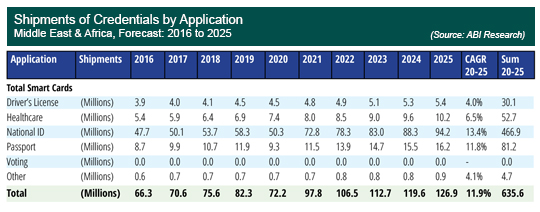4Q 2020 | IN-5973
Registered users can unlock up to five pieces of premium content each month.
Identities Framework in Malawi |
NEWS |
Over a three-year period, Malawi has developed from a country without any form of National ID system or centralized registry of peoples to a country with a high coverage identities infrastructure accompanied by a biometric ID card. Undertaking a National ID program is a significant undertaking for any country, with significant capital and expertise required across the value-chain, from enrollment of citizens biometric data, procuring raw credentials, personalization and installing physical/digital infrastructure for access to government or e-government services. This makes the Malawian project a significant achievement for the region, considering Malawi’s status as an emerging economy.
A Significant Achievement |
IMPACT |
Only as recently as 2017, Malawian citizens relied on piecemeal documentation such as voting cards and drivers’ licenses in a legacy format and existed as one of the only countries in the south of the continent to lack either a national citizen registry or a National ID system. The only consistent form of up-to-date identification was that of the voter card, a credential for which registration was performed on a four-year basis for political elections. As the 2019 elections came closer, the United Nations Development Program (UNDP) and the Malawian government sought to instigate a more permanent solution to the identity vacuum.
The first stage was setting up a Civil Registry and Vital Statistics (CRVS) system to accurately record births and deaths in the country, which became a reality with the support of UK Aid, Irish Aid, USAID, the EU and the Norwegian government. This streamlined access to government services and eliminated “ghost” pensioners and workers and citizens fraudulently utilizing the national healthcare system. Typically, as part of a mass-registration government identity program (especially when migrating from legacy to smart credentials), there will be a pilot scheme with enrollment carried out in select areas or regions. The Malawian government elected not to include a pilot stage, instead aiming to have registered the biometrics of over 9 million Malawian citizens by June 2018.
Africa as a region does not have a consistent track record as it relates to National ID project budget and timescale limitations, however by November 2017, 9.1 million citizens had been biometrically registered. Shortly after, citizens were issued with biometric National ID cards, complete with travel functionality for national flights as well as healthcare applications linked to the national healthcare system, reducing the number of credentials necessary for the citizen to carry. Furthermore, banks are able to verify new and existing customers with ease, the passport application process is now streamlined, and local offices are retaining the biometric kits for ongoing registration in the community.
Smart ID Card Growth in Africa |
RECOMMENDATIONS |
The Government ID smart card market can be a slow-moving beast and remains heavily project-driven, a number of which have now been initiated or planned to kick off imminently in the region of Africa. However, the ongoing COVID-19 pandemic has caused a significant amount of disruption and delay with a number of projects pushed back to 2021. Closure of enrollment centers due to limitations imposed on in-person meetings means that biometric data is more difficult to capture within the desired timeframe and this can lead to ongoing budgetary issues. Furthermore, for programs already through the enrollment stage, the personalization and physical printing of the credentials themselves are also seeing delays as personalization centers close down during lockdowns, leading to delays in getting documents into the hands of citizens, and meaning some will have reduced access to government aid and services; something which is increasingly important during a global pandemic.
Specifically, to emerging economies in Africa, the COVID-19 pandemic also provides another stumbling block. For countries that are looking to migrate from a legacy to a smart credential with a limited amount of capital to leverage, one solution is that of using a contact-only IC in the smart card, the interface with the most accessible ASP to emerging economies. However, with governments looking to digitize services and expand the model of contactless experiences in order to reduce the transmission of the virus, contact-only IC’s may not be the best option to achieve this goal. As a result, some countries will face the choice of investing in a pure contactless or dual-interface IC at an increased price-point or issuing a credential which requires contact with readers and other infrastructure to access government services.
Alternatively, this may simply result in a project postponement until 2021, such as we are seeing in Ghana, Kenya, Uganda and Nigeria. As the data below suggests, 2020 will see the Middle East and Africa suffer a YoY decrease in issuance of smart National ID’s, falling from 58.3 million units in 2019 to 50.3 million in 2020 as a result of closures of personalization and enrollment centers, however this is expected to rise in 2021 to 72.1 million units as the backlog of credentials begins to be issued.

Besides the physical credential, the other option is that of a mobile credential. Governments are not looking toward mobile as a replacement for the physical, but rather using mobile technology to expand levels of digitization and use as a platform to introduce new levels of flexibility and convenience, improve G2C and C2G communication, and bolt on new digital services, available 24/7.
The primary inhibitor for this is the penetration rate of smartphones in the region which stands lower than that of Europe or Asia and limits the number of citizens which can access such a solution. The likelihood will be that countries will simply wait out the COVID-19 pandemic and begin to enroll citizens and issue credentials from 2021, which will provide strong growth in the region into the forecast period as can be seen from the table above. For more granular data, please see MD-GHSC-24 Government and Healthcare ID Cards.